DeX-Platform is an advanced application development platform designed for industrial robot control systems by Valkyrie Smart Technology. It offers a comprehensive solution, from hardware to software, enabling users to develop intelligent applications efficiently.
With DeX-Platform, developers can create standard application packages for industrial robots, integrate vision systems quickly, and meet the needs of non-standard applications across various types of robots. They can even build their own upper-level programming teaching systems or develop independent software solutions for research, education, or maker projects. This platform significantly enhances the development and improvement of industrial robot-related solutions.
Why was such a system developed? Consider this scenario: “I have a great idea that helps the chef manage recipes on a computer!†“Great, let’s start developing this computer!â€
This absurd situation is actually happening in the field of industrial robots today. In the past, industrial robots were limited in their applications, with core technologies controlled by a few companies. Traditional industrial robots, like those from the four major international brands, focused on creating proprietary technology packages and didn’t offer many open development interfaces.
As market demand expanded and technologies like AI, sensors, and core components evolved, the application of industrial robots began to grow beyond traditional manufacturing. Now, they are used in areas like medical surgery, film production, amusement parks, and even unmanned restaurants.
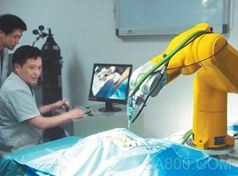
Medical Surgery

Filming
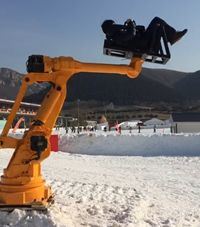
Recreation Facilities
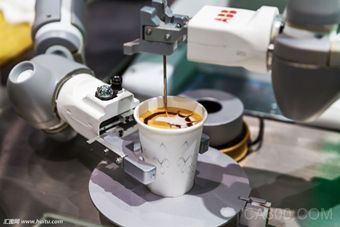
FOOD
As these new applications emerged, the need for more flexible and diverse control systems became evident. However, traditional manufacturers were not able to keep up with all the new demands, especially in the civil service sector. Many domestic manufacturers also adopted closed systems, making it difficult for developers to access the necessary tools and resources.
Because of this, many new developers ended up building their own robotic systems from scratch, which required 80% of their time and effort just on the hardware and underlying systems. This led to an inefficient model where developing an application meant first building the system that would run it.
According to the "China Robot Industry Development Report (2017)," domestic industrial robot sales exceeded 110,000 units in 2017, with a market size of $4.22 billion. However, this includes foreign product shares. Even if foreign products accounted for only half, the domestic market was still much smaller than industries like mobile phones or gaming.
This highlights the challenges facing China's industrial robotics industry. While it has potential, the current development model is not mature enough to support rapid growth. The smartphone industry, by contrast, thrived due to a collaborative ecosystem where developers could easily contribute without needing to build the entire system themselves.
The key to unlocking the potential of industrial robots lies in creating a similar open and accessible platform. DeX-Platform aims to do just that by providing a general-purpose development environment that reduces the barriers to entry for developers.
DeX-Platform supports both hardware and software development, offering a complete system that allows developers to focus on upper-level applications without worrying about the underlying infrastructure. It integrates powerful motion planning algorithms, advanced industrial bus technologies, and a Linux-based SDK to help developers quickly implement visual applications and other complex tasks.
For example, in intelligent sorting applications using machine vision, DeX-Platform enables developers to calibrate coordinate systems, detect target positions, and plan robot movements efficiently. It also supports advanced trajectory planning, allowing for smooth and accurate robotic operations.
Another key feature of DeX-Platform is its drag teaching and synchronous replay function. Based on zero-force control technology, it allows operators to manually guide the robot, which can then be recorded and replayed. This makes robot programming more intuitive and accessible, reducing the need for complex coding.
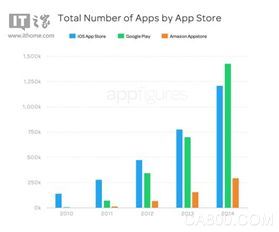
Three Application Store Application Growth Histogram

The Number of Application Developers in the Three Platforms Increased Histogram
By fostering a more open and collaborative environment, DeX-Platform aims to drive innovation in the industrial robot industry. It provides developers with the tools they need to create new applications, improve efficiency, and bring their ideas to market faster. As the industry continues to evolve, platforms like DeX-Platform will play a crucial role in shaping the future of industrial automation.
DeX-Platform also supports integration with various artificial intelligence systems and solutions. Valkyrie Smart Technology is working with multiple companies to validate and bring new applications to market quickly and cost-effectively. By continuously improving the platform and adding new features, we aim to make industrial robot development more accessible and efficient for everyone.
24HR Electronic Timer socket with photocell.
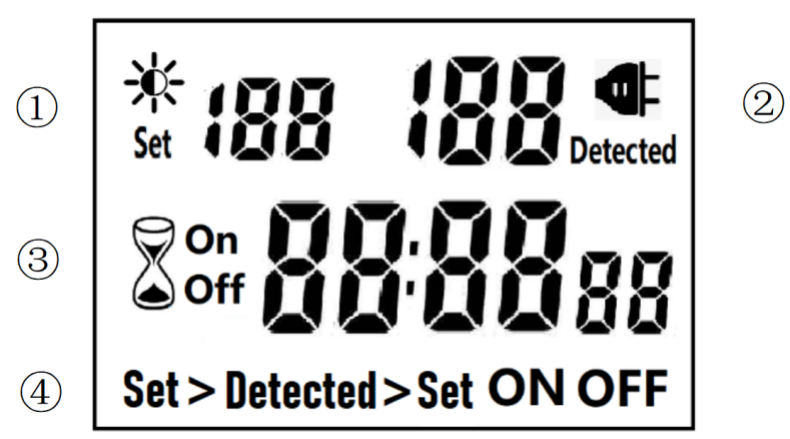
â‘ Light intensity setting
â‘¡ Light intensity detection
â‘¢ Countdown Timer ON & OFF
â‘£ 4 MODES:
Set > Detected: When the light intensity detection value is less than the set value, switch ON or OFF.
Detected > Set: When the light intensity detection value is greater than the set value, switch ON or OFF
ON : Always ON
OFF : Always OFF
NOTED:
1. The light intensity displayed by this machine is not the standard light intensity value (Lux), only the relative light intensity value.
2. The light intensity value is affected by the placement position and direction. Please determine the position first and then set it according to the actual light intensity detected. If you change the position or change the orientation, you need to reset the light intensity setting value suitable for the new position.
3. This product has built-in rechargeable battery. If it is not connected to AC for a long time, you need to connect the power supply to charge until the LCD can display normally.
MANUAL OPERATION
1. Press [UP" or [DOWN" to set the LUX value.
2. Press the [SET" key to start setting, and the P1 settable items will be flashed.
3. Press [UP" or [DOWN" to adjust the value.
4. Press [SET" key again to exit setting or enter next setting for countdown timer.
5. Repeat the [SET" key to start setting, and the P2 & P3 settable items will be flashed.

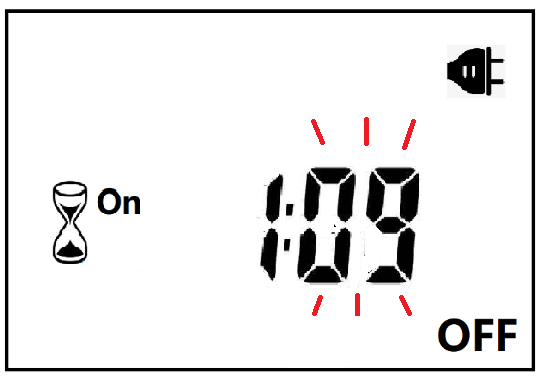

6. Press the [FUN" key to switch the working state in the following:
Set > Detected -> Detected > Set -> ON -> OFF
Set > Detected: Automatically switches when the detected ambient light intensity is darker than the set value
Detected >Set: Automatically switch when the detected ambient light intensity is brighter than the set value
When the brightness meets the setting conditions, the countdown starts as below:
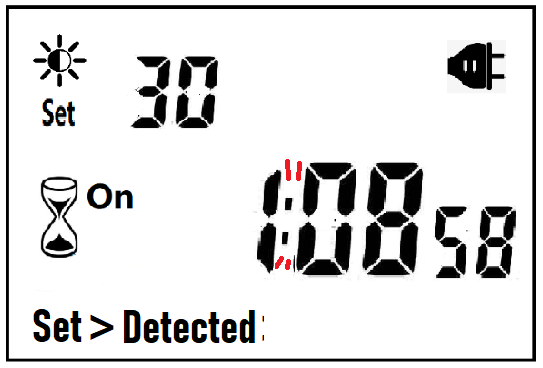
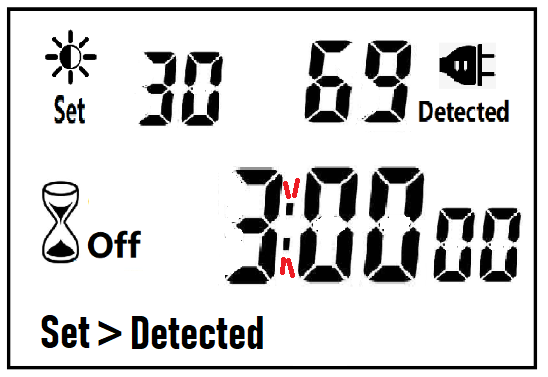
Note:when the countdown is ON, the detected value is not displayed.
When the brightness does not meet the setting conditions, the countdown stops and waits:
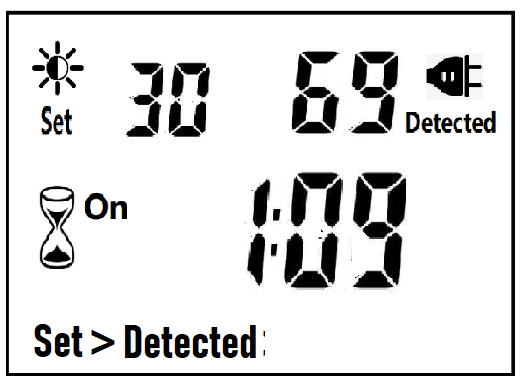
After the countdown ON is reduced to 0, the countdown OFF starts immediately and the power is OFF.
After the countdown OFF is reduced to 0:
A. If the light intensity meets the set conditions, a new round of countdown will be started;
B. If the light intensity does not meet the set conditions, keep the power off and wait for the light to meet the conditions before turning on automatically.
NOTE:
1. If the power is cut off while the countdown is running, the countdown will be terminated immediately and the relay output will be off. After the power is turned on again, a new round of brightness detection will start.
2. Modifying the brightness value in the countdown operation will not affect the current countdown operation. After the off time of the current countdown, the new brightness setting value will take effect.
3. In the countdown on operation, change the setting value of the countdown on, this countdown will still be timed according to the original setting value; the new setting value will take effect when the next countdown on starts.
4. In the countdown off operation, change the setting value of countdown off, this countdown will still be timed according to the original setting value; the new setting value will take effect when the next countdown off is started.
NOTE: the brightness setting value, countdown ON or countdown OFF, any one of which is equal to 0, cannot be switched ON or OFF automatically.
Manual Control
When ON or OFF is displayed, it means that the power supply remains ON or OFF, as shown in the figure below:

Power Detection and Standby Mode
With AC power supply, the icon ![]() lights up and works normally.
lights up and works normally.
When there is no AC power supply, the icon ![]() goes out, the brightness is not detected at this time, and the system enters the standby mode.
goes out, the brightness is not detected at this time, and the system enters the standby mode.
Photocell Timer, photocell timer socket, photocell sensor, photocell sensor socket, sensor plug, sensor switch socket, digital photocell timer, digital sensor timer
NINGBO COWELL ELECTRONICS & TECHNOLOGY CO., LTD , https://www.cowellsocket.com
